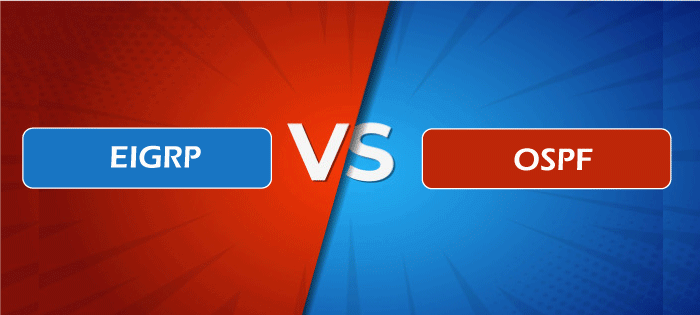Difference between EIGRP and OSPFEIGRP and OSPF are inner gateway routing protocols that aid in the selection of routes for data transmission or sharing by interacting with routers. The earlier protocol EIGRP utilizes is a distance vector routing protocol, and the later protocol, OSPF, utilizes a link-state routing protocol. However, EIGRP and OSPF can both learn dynamic routes for the network, and there are many differences between them. For example, the EIGRP protocol is a Cisco proprietary IGP, and it is only utilized in Cisco networks. In contrast, OSPF is the enterprise network's open standards IGP. In this article, you will learn about the difference between EIGRP and OSPF. But before discussing the differences, you must know about EIGRP and OSPRF with their advantages and disadvantages. What is EIGRP?EIGRP is an abbreviation for "Enhanced Interior Gateway Routing Protocol". It is a distance vector protocol that is based on Cisco that runs on DUAL (Diffusing Update Algorithm). It is mainly utilized to share data from one router to neighbouring routers in the same region. However, EIGRP is a complicated protocol, and it is easy to configure and operate in both small and large networks. It was designed to resolve the problems of traditional distance vector routing protocols like RIP (Routing Information Protocol) and IGRP, which were complex to scale to meet the needs of the network. EIGRP is a hybrid protocol as it combines aspects of the distance vector routing protocol and the link-state routing protocol. EIGRP gets its updates from its neighbours, like the distance vector routing system. Similarly, the EIGRP protocol maintains a topology table of the announced routes and employs the Diffusing Update Algorithm (DUAL) as the link-state protocol to select a loop-free path. Advantages and Disadvantages of EIGRPThere are various advantages and disadvantages of EIGRP. Some main advantages and disadvantages of EIGRP are as follows: Advantages
Disadvantages
What is OSPF?OSPF is an abbreviation for "Open Shortest Path first". It is an open standard routing protocol similar to the EIGRP protocol, and it is an open IETF standard that may be utilized in many networks. The OSPF's development focused on developing a link-state protocol that may offer more scalability and efficiency than the Routing Information Protocol. It runs on protocol number 89, uses the AD value 110, and has a dependable transportation mechanism. OSPF is a low-class routing protocol that also helps with variable-length subnet masking (VLSM) and discontinuous networks. It utilizes multicast addresses 224.0.0.5 and 224.0.0.6 to send Hello and updates. There is also a provision of authentication in the OSPF protocol, which comes in two flavours: basic test and message-digest algorithm 5. The OSPF employs the Dijkstra algorithm to compute routes by creating the shortest path tree (SPT). In link-state ads, each router displays itself and its links to its neighbours straightforwardly and understandably, allowing OSPF to lay out the network topology using information from the shortest-path tree. Advantages and Disadvantages of OSPFThere are various advantages and disadvantages of OSPF. Some main advantages and disadvantages of OSPF are as follows: Advantages
Disadvantages
Key differences between EIGRP and OSPF
Here, you will learn the various key differences between EIGRP and OSPF. Some main differences between EIGRP and OSPF are as follows:
Head-to-head comparison between EIGRP and OSPFHere, you will learn the head-to-head comparisons between EIGRP and OSPF. The main differences between EIGRP and OSPF are as follows:
ConclusionWhen you compare the EIGRP and OSPF protocols, you can see that EIGRP is more complicated, whereas OSPF is simpler because it only utilizes cost as a measure. The main distinction between both protocols is that EIGRP exchanges complete routing data just once when neighbouring routes are established and then only tracks modifications. In contrast, the OSPF protocol consistently keeps track of the entire topology database of all the connections in the database.
Next TopicDifference between
|
 For Videos Join Our Youtube Channel: Join Now
For Videos Join Our Youtube Channel: Join Now
Feedback
- Send your Feedback to [email protected]
Help Others, Please Share










